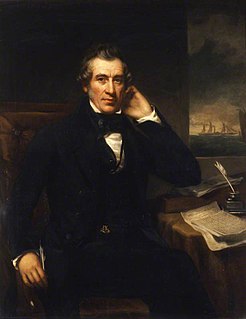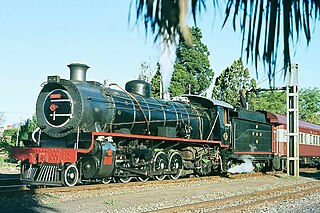Related Research Articles

The Great Bear, number 111, was a locomotive of the Great Western Railway. It was the first 4-6-2 (Pacific) locomotive used on a railway in Great Britain, and the only one of that type ever built by the GWR.
Sir Henry Fowler, was an English railway engineer, and was chief mechanical engineer of the Midland Railway and subsequently the London, Midland and Scottish Railway.

Sir William Fairbairn, 1st Baronet of Ardwick was a Scottish civil engineer, structural engineer and shipbuilder. In 1854 he succeeded George Stephenson and Robert Stephenson to become the third president of the Institution of Mechanical Engineers.
George Jackson Churchward was an English railway engineer, and was chief mechanical engineer of the Great Western Railway (GWR) in the United Kingdom from 1902 to 1922.
The Great Western Railway County Class were a class of 4-4-0 steam locomotives for express passenger train work introduced in 1904 in a batch of ten. Two more batches followed in 1906 and 1912 with minor differences. They were designed by George Jackson Churchward, who used standard components to produce a four-coupled version of his Saint Class 4-6-0s.
The Highland Railway River class was a class of steam locomotive with a 4-6-0 wheel arrangement. They were designed by F. G. Smith, who had joined the Highland Railway in 1904 from the North Eastern Railway. His initial post was as manager of the Locomotive, Carriage and Wagon works at Inverness. When Peter Drummond departed to the Glasgow and South Western Railway at the end of 1911 Smith was appointed Chief Mechanical Engineer in his place.
The axle load of a wheeled vehicle is the total weight bearing on the roadway for all wheels connected to a given axle. Axle load is an important design consideration in the engineering of roadways and railways, as both are designed to tolerate a maximum weight-per-axle ; exceeding the maximum rated axle load will cause damage to the roadway or rail tracks.

The Great Western Railway (GWR) 6000 Class or King class is a class of 4-6-0 steam locomotive designed for express passenger work and introduced in 1927. They were the largest locomotives built by the GWR, apart from the unique Pacific. The class was named after kings of the United Kingdom and of England, beginning with the then reigning monarch, King George V, and going back through history. They handled the principal GWR expresses on the main line from London to the West of England and on the GWR main line to Birmingham and Wolverhampton, until 1962 when the class was withdrawn.

The Indian Railways primarily operates fleet of electric and diesel locomotives, along with several compressed natural gas (CNG) locomotives. Steam locomotives are operated on a few World Heritage sites and also run occasionally as heritage trains. A locomotive is also known as a loco or more popularly as an engine. The country's first steam locomotive ran on the Red Hill Railway from Red Hills to the Chintadripet bridge in Madras in 1837.
In rail terminology, the hammer blow is a vertical force which alternately adds to and subtracts from the locomotive's weight on a wheel. It is transferred to the track by the driving wheels of many steam locomotives. It is an out-of-balance force on the wheel. It is the result of a compromise when a locomotive's wheels are unbalanced to off-set horizontal reciprocating masses, such as connecting rods and pistons, to improve the ride. The hammer blow may cause damage to the locomotive and track if the wheel/rail force is high enough. 'Dynamic augment' is the US term for the same force.

Sir Charles Edward Inglis, OBE, FRS was a British civil engineer. The son of a doctor, he was educated at Cheltenham College and won a scholarship to King's College, Cambridge, where he would later forge a career as an academic. Inglis spent a two-year period with the engineering firm run by John Wolfe-Barry before he returned to King's College as a lecturer. Working with Professors James Alfred Ewing and Bertram Hopkinson, he made several important studies into the effects of vibration on structures and defects on the strength of plate steel.
The Einheitsdampflokomotiven, sometimes shortened to Einheitslokomotiven or Einheitsloks, were the standardized steam locomotives built in Germany after 1925 under the direction of the Deutsche Reichsbahn-Gesellschaft. Their manufacture made extensive use of standard design features and components.

The South African Railways Class 14C 4-8-2 of 1922 was a steam locomotive.
A divided drive locomotive is a steam locomotive that divides the driving force on its wheels by using different cylinders to power different pairs of driving wheels in order to give better weight distribution and reduce "hammer blow" which can be damaging to the track, or else to enable the wider spacing of the driving wheels to accommodate a larger firebox.
The GS&WR 400 class or CIE class B2/B2a were a class of ten 4-6-0 steam locomotives built for the Great Southern & Western Railway (GS&WR) between 1916 and 1923 for express passenger duties on the Dublin to Cork main line. They proved initially unreliable but rebuilds from four to two cylinders between 1927 and 1937 for the seven survivors produced locomotives that proved satisfactory with the last two being withdrawn in 1961.

The South African Railways Class 14C 4-8-2 of 1918 was a steam locomotive.

The South African Railways Class 14C 4-8-2 of 1919 was a steam locomotive.

The South African Railways Class 14C 4-8-2 of 1919 was a steam locomotive.
The L&YR 2-10-0 was a prospective design for a class of 2-10-0 steam locomotives on the Lancashire and Yorkshire Railway. Initial designs were made by George Hughes between 1913–1914, but none of the class were built. If they had been, these would have been the UK's first 10-coupled locomotives in regular service.

The Midland Great Western Railway (MGWR) A Class, later Inchicore Class D5, consisted of 6 4-4-0 express passenger locomotives built at Broadstone Works in the period 1902-1905. The largest express passenger locomotive in Ireland for a short while after introduction they were used on the MGWR's flagship services to Galway with most surviving until the 1950s albeit on less prestigious work.
References
- ↑ Nock (1983) 232.
- Nock, O.S. (1983). "Chapter 16, 'The bridge stress committee and locomotive design'.". British Locomotives of the 20th Century. Volume 1 1900-1930. London: Book Club Associates. pp. 233–251.
- Gribble. "Impact in Railway-Bridges, with Particular Reference wo the Report of The Bridge Stress Committee". Minutes of the Proceedings of the Institution of Civil Engineers. the Institution of Civil Engineers. 228 (1929): 46–79. ISSN 1753-7843.
- Department of Scientific and Industrial Research, Bridge Stress Committee (1928). Report. London: HMSO.